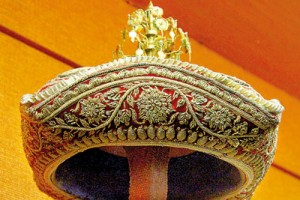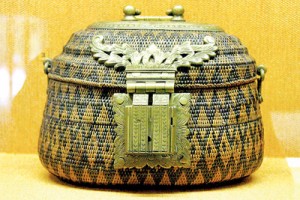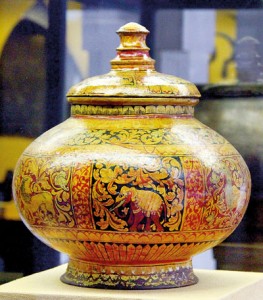Monument to all things Kandyan

Beautifully restored: Tha Pallewahala building that houses the Kandy National Museum. Pix by Indika Handuwala
Ear droplets adorned with the most exquisite gems tell a tale of love, lust and tears. A gold-laced goblet once held captive between the royal lips may have stolen moments of meaningful glances exchanged over its rim. The palanquin of Molligoda Nilame waits patiently till the next destination is ordered by its aristocratic master. The swords of Kandyan metal flash with rebellious air and Keppetipola Disavaâs flag still flies high.
The Kandy National Museum, housed in former Pallewahala or the Palace of the Concubines of the last monarch of the country- Sri Wickrama Rajasingha was re-opened to the public a few weeks ago after a demanding refurbishment project of nearly three years. The hard work has not been in vain. The visitor is enveloped by its cool interiors and is instantly transported to the ethos of the Kandyan kingdom amidst the timbre of the thewawa ceremony and the vigour of the Kandyan dancersâ vannam beats, innovatively brought alive within its walls.
Originally opened in 1942 as the first branch museum of the Colombo National Museum which was inaugurated in 1877, the Kandy National Museum is a fine reflection of the cultural fabric of the entire Kandyan era, threaded by royalty, aristocracy, the common man and the influence of colonialism. The recently concluded refurbishment and conservation effort at the Kandy National Museum entailed an investment of around Rs 20 million, Director, National Museums, Sanuja Kasthuriarachchi told the Sunday Times. âThe refurbishment project was aligned with the principle of âmonument conservationâ and the fundamental theory in such conservation is zero-alteration to the original architecture,â explained Ms. Kasthuriarachchi.
The lighting of the interior is enhanced to highlight the exhibits, while doing justice to the ambience of the interiors. Conservation team head Nilmini Neththasinghe describing the project said, âWe were conscious of the delicate condition of some of the objects, even when moving them out.â She cited the flag of the Keppetipola Disava, ivory-carved objects and rare tools of agriculture such as bogawa made of Beduru leaves (a head gear resembling a winnowing fan or a kulla worn by Kandyan farmers to counter rain and sun) among them.
The number of exhibits had also been increased giving a broader insight into aspects of Kandyan living. Nearly 1000 exhibits including royal regalia, garments of aristocracy, utensils used in the royal kitchens, jewellery and other ornaments, brass and clay objects, lacquer (laksha) and ivory artefacts, ancient board games, arms and weapons, palanquins, agricultural tools and clappers tied around cows and elephants are on display.

Artifacts aplenty: Well illuminated and displayed
The assortment of betel chewing equipment (giraya) adorned with a womanâs figure in worshipping position, a face mirror believed to have been used by a queen, the spoon holder or hendiaana and the jaggery moulds used in King Rajasinhaâs royal kitchen, official royal court attire of Keppetipola Disawa and a wooden puzzle known as magulparakkuwa which was often used to test the intelligence of a potential groom by a brideâs father are among the interesting and rare items that will enthral the visitor.
The conservation project which unearthed the original floor of the building, paved with burnt floor tiles or bricks and stone slabs mirrors one of the signature features of Kandyan architecture, as our committed and informed guide and museum keeper, K.D.V. Chandimal enthusiastically informed us. This original flooring had been buried under a layer of cement before the renovation project and as he said, the excavations in the interior of the building had also revealed alterations done by the British. Portions of this Kandyan-European fusion are exposed to the visitor as part of the learning experience. âHowever, a large proportion of the original pallewahala structure still remains despite the changes done by the British when this building was used as a hospital for the British at one time and then later as an administrative building,â explains Chandimal. The ventilation mechanism installed under the dome of the roof is an addition by the British.
With a roof that entails complex Kandyan wooden designs, madolkurupawa, kombudangaraya and supported by beams and rafters replete with carvings, centre courtyards with windows scientifically placed to retain cool air and prevent the absorption of excess heat, lime plastered walls and large doorways, the museum building mirrors all distinct features of a Kandyan state building. âIt is assumed that the architect of this building is Devendra Mulachari, the royal artificer responsible for most iconic structures of the Kandyan kingdom, including the Magul Maduwa and Paththirippuwa,â says Chandimal.The famous cubic metre of Devendra Mulachari is also among the exhibits.
Several contemporary double-lid and single-lid doorways comprising nine features of a distinct âKandyan doorâ which the scholar Ananda Coomaraswamy makes reference to in his work, Medieval Sinhalese Art, make one visualize the royal concubines stepping out of them into the inner courtyard of the then pallewahala to enjoy the cool morning air. âAlthough the partitions of apartments are not visible today, doorways opening to the courtyard imply that there had been several of them,â says Chandimal who adds that Venkatha Rangammal, the chief queen of Sri Wickrama Rajasinha lived in the adjoining building in the same compound known as Medavasala.

Head gear of Keppetipola Disave
A majority of the artefacts are said to have been the collection of a British Government Agent, John Dixith, who acquired several items of historical value from Kandy and Matale. âHe had been a collector and when his term of office came to an end in the late 1800s, all what he had deposited in a room of his kachcheri office, was transferred to the Kandyan Art Society. From there, the collection was re-deposited at the then pallewahala which was the chosen location to open the first branch of the National Museum in 1942 under then Director, National Museum of Ceylon, Dr. P.E.P. Deraniyagala,â the museum keeper explains. The collection which was at the mercy of the elements, was conserved and expanded through donations from time to time.
The Museum located at Anagarika Dharmapala Mawatha, Kandy (behind the Dalada Maligawa and opposite the old Courts complex) is open from Tuesday to Saturday from 9 a.m to 5 p.m. (closed on Sunday, Monday and all public holidays).

A storage box

A lacquer (laksha) jewellery storage container


